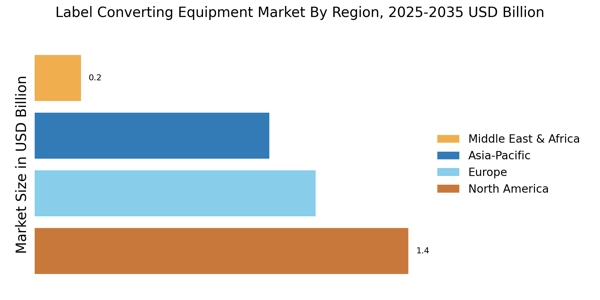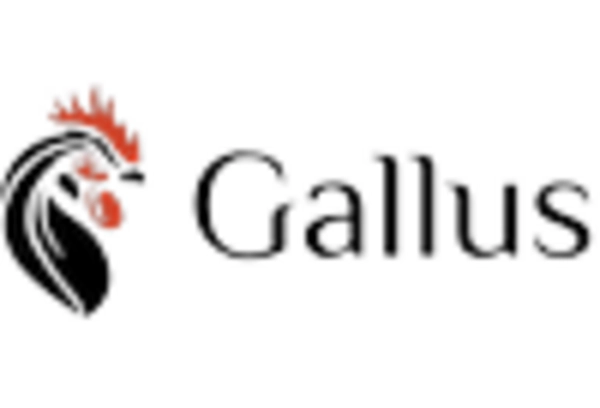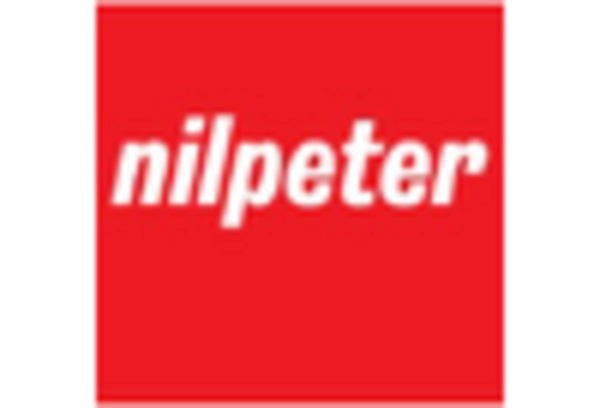Rising Demand for Customization
The Label Converting Equipment Market is experiencing a notable increase in demand for customized labeling solutions. As businesses strive to differentiate their products, the need for unique labels that reflect brand identity has surged. This trend is particularly evident in sectors such as food and beverage, cosmetics, and pharmaceuticals, where personalized labels can enhance consumer engagement. According to recent data, the customization segment is projected to grow at a compound annual growth rate of approximately 5.5% over the next five years. This growth is likely to drive investments in advanced label converting technologies, enabling manufacturers to meet the evolving needs of their clients. Consequently, the Label Converting Equipment Market is poised to benefit from this shift towards tailored solutions, as companies seek to leverage innovative equipment to produce high-quality, bespoke labels.
Technological Innovations in Labeling
Technological advancements are playing a pivotal role in shaping the Label Converting Equipment Market. Innovations such as digital printing, automation, and smart labeling technologies are enhancing the efficiency and quality of label production. For instance, digital printing allows for shorter production runs and quicker turnaround times, which is increasingly important in a fast-paced market. Furthermore, automation in label converting processes can significantly reduce labor costs and improve precision. Recent market analyses suggest that the adoption of these technologies could lead to a 20% increase in production efficiency for label manufacturers. As companies seek to optimize their operations, the Label Converting Equipment Market is likely to witness a surge in demand for state-of-the-art equipment that incorporates these technological advancements.
Growth of E-commerce and Online Retail
The rapid expansion of e-commerce and online retail is significantly influencing the Label Converting Equipment Market. As more businesses transition to online platforms, the demand for efficient and effective labeling solutions has intensified. E-commerce companies require labels that not only comply with shipping regulations but also enhance brand visibility during transit. Recent statistics indicate that e-commerce sales are expected to reach over 4 trillion dollars by 2025, which could lead to an increased need for label converting equipment that can handle high volumes and diverse label formats. This trend suggests that manufacturers of label converting equipment must adapt to the changing landscape by offering versatile solutions that cater to the specific requirements of online retailers. Thus, the Label Converting Equipment Market stands to gain from the ongoing digital transformation in retail.
Sustainability and Eco-friendly Practices
The growing emphasis on sustainability is influencing the Label Converting Equipment Market in profound ways. As consumers become more environmentally conscious, companies are increasingly adopting eco-friendly labeling solutions. This includes the use of biodegradable materials and sustainable printing processes. Recent surveys indicate that over 70% of consumers prefer products with sustainable packaging, which is prompting manufacturers to invest in equipment that supports these initiatives. The shift towards sustainability not only meets consumer demand but also aligns with regulatory pressures for reduced environmental impact. Consequently, the Label Converting Equipment Market is likely to see a rise in the development and adoption of sustainable labeling technologies, which could enhance brand loyalty and market competitiveness.
Regulatory Compliance and Safety Standards
The Label Converting Equipment Market is also being driven by the need for compliance with stringent regulatory standards. Various sectors, including pharmaceuticals, food and beverage, and chemicals, are subject to rigorous labeling regulations that ensure product safety and consumer protection. As these regulations evolve, manufacturers are compelled to invest in label converting equipment that meets compliance requirements. Recent data suggests that the market for compliant labeling solutions is expected to grow by approximately 4% annually, reflecting the increasing importance of safety and transparency in product labeling. This trend indicates that the Label Converting Equipment Market must prioritize the development of equipment that not only meets regulatory standards but also enhances the overall quality and reliability of labels.


















Leave a Comment